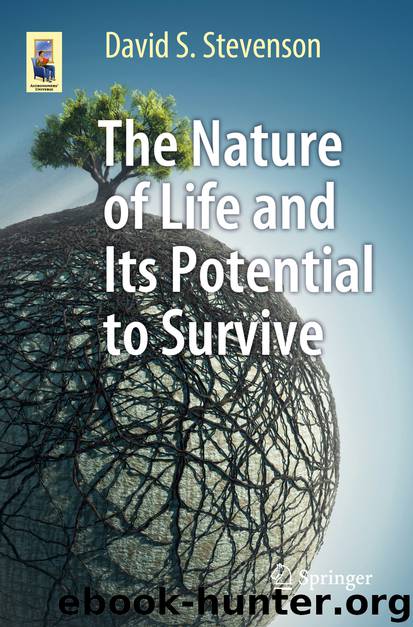The Nature of Life and Its Potential to Survive by David S. Stevenson

Author:David S. Stevenson
Language: eng
Format: epub
Publisher: Springer International Publishing, Cham
Finally, biology produces some signature gases. Although methane makes a good molecule with which to identify anaerobic respiration, it is also produced abundantly through the reaction of carbon dioxide, water and olivine in serpentinization (Chaps. 2 and 3). It is also abundant in the atmospheres of gas and ice giants such as Jupiter and Neptune. Therefore, it is not ideal. Oxygen, on the other hand, though produced by the photolysis of water and carbon dioxide, is only present in abundance through the action of oxygenic photosynthesis (Chap. 3). Its reactivity precludes it from loitering within an atmosphere unless it is generated continuously.
If we rule out the small proportion of worlds in which a thermal runaway is boiling its oceans dry, then any planet with abundant oxygen is likely to harbor life. This is because planets with temperatures 15–30 °C hotter on average than Earth are likely to be experiencing the kind of thermal runaway that Earth can look forward to in 1–2 billion years hence. Here, copious atmospheric moisture is likely to be accompanied by enhanced photolysis and the production of oxygen. In such worlds one might mistake evidence of life with evidence for its catastrophic demise. Such a process could be protracted, depending on how quickly its star is evolving, but it seems fairly likely we could segregate these marginal worlds with more clement spheres upon which life is still likely to persist.
Therefore, we should target planets with an average temperature less than 30–35 °C. Find one with an oxygen-rich atmosphere, and we are likely to hit the jackpot. But be warned of those very young worlds that lie under the gaze of ultraviolet-emitting dwarf stars. As Peter Wheatley and colleagues showed young red dwarfs likely emit enough ultraviolet light to strip any planets in their habitable zone. However, this may only be a risk for the lowest mass red dwarfs. Here, planets must orbit within a few million kilometers of their star’s surface and thus be subject to the most fierce irradiation. It may also be a transient phenomenon, where the planet’s reserves of moisture are able to reconstitute its atmosphere from its mantle after the tempestuous red dwarf settles down.
Perhaps then, we should be cautious. By narrowing our search to exclude those very young stars and planets (less than 1 billion years old), we can exclude those worlds that have oxygen atmospheres produced by photolysis. Think of Earth. Perhaps Sanjoy Som has identified a period when Earth was nearly bled dry by its young, ultraviolet Sun. A distant observer may have seen a planet bleeding oxygen to space and concluded we were already playing host to an oxygen-rich atmosphere. Through careful discrimination we should be able to identify mature, temperate worlds in which life has crafted an atmosphere rich in oxygen and organics.
Aside from oxygen, plants also produce a rich tapestry of other chemicals. Plants actively emit an array of chemicals, such as terpenes—small hydrocarbon-like molecules. These serve as chemical messengers between plants and as messengers between plants and insects.
Download
This site does not store any files on its server. We only index and link to content provided by other sites. Please contact the content providers to delete copyright contents if any and email us, we'll remove relevant links or contents immediately.
Man-made Catastrophes and Risk Information Concealment by Dmitry Chernov & Didier Sornette(5956)
The Revenge of Geography: What the Map Tells Us About Coming Conflicts and the Battle Against Fate by Kaplan Robert D(4052)
Zero Waste Home by Bea Johnson(3805)
COSMOS by Carl Sagan(3589)
Good by S. Walden(3521)
In a Sunburned Country by Bill Bryson(3508)
The Fate of Rome: Climate, Disease, and the End of an Empire (The Princeton History of the Ancient World) by Kyle Harper(3033)
A Wilder Time by William E. Glassley(2835)
Camino Island by John Grisham(2778)
Organic Mushroom Farming and Mycoremediation by Tradd Cotter(2661)
The Ogre by Doug Scott(2657)
Human Dynamics Research in Smart and Connected Communities by Shih-Lung Shaw & Daniel Sui(2479)
Energy Myths and Realities by Vaclav Smil(2463)
The Traveler's Gift by Andy Andrews(2436)
9781803241661-PYTHON FOR ARCGIS PRO by Unknown(2343)
Inside the Middle East by Avi Melamed(2328)
Birds of New Guinea by Pratt Thane K.; Beehler Bruce M.; Anderton John C(2236)
A History of Warfare by John Keegan(2214)
And the Band Played On by Randy Shilts(2166)
